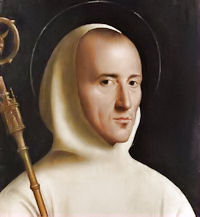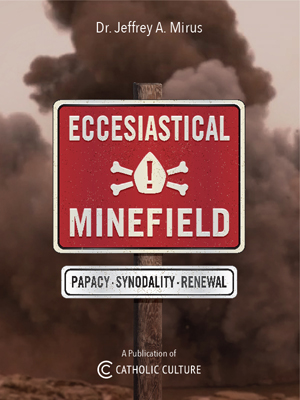Lent: April 1st
Wednesday of the Fifth Week of Lent
Other Commemorations: St. Hugh of Grenoble, Bishop (RM)
» Enjoy our Liturgical Seasons series of e-books!
"One of the scribes came to Jesus and asked him, “Which is the first of all the commandments?” Jesus replied, “The first is this: Hear, O Israel! The Lord our God is Lord alone! You shall love the Lord your God with all your heart, with all your soul, with all your mind, and with all your strength. (Mk 12:28)."
Historically today is the feast of St. Hugh of Grenoble, who was elected bishop at the age of twenty-eight to purge the diocese of its disorders, and he occupied the see until his death fifty-two years later.
Meditation - The Tree of Knowledge and the Cross
The sin that was wrought through the tree was undone by the obedience of the tree, obedience to God whereby the Son of man was nailed to the tree, destroying the knowledge of evil, and bringing in and conferring the knowledge of good; and evil is disobedience to God, as obedience to God is good. And therefore the Word says through Isaiah the prophet, foretelling what was to come to pass in the future—for it was because they told the future that they were "prophets"—the Word says through him as follows: I refuse not, and do not gainsay, my back have I delivered to blows and my cheeks to buffets, and I have not turned away my face from the contumely of them that spat. [Is. 50, 6] So by obedience, whereby He obeyed unto death, hanging on the tree, He undid the old disobedience wrought in the tree. And because He is Himself the Word of God Almighty, who in His invisible form pervades us universally in the whole world, and encompasses both its length and breadth and height and depth—for by God's Word everything is disposed and administered—the Son of God was also crucified in these, imprinted in the form of a cross on the universe; for He had necessarily, in becoming visible, to bring to light the universality of His cross, in order to show openly through His visible form that activity of His: that it is He who makes bright the height, that is, what is in heaven, and holds the deep, which is in the bowels of the earth, and stretches forth and extends the length from East to West, navigating also the Northern parts and the breadth of the South, and calling in all the dispersed from all sides to the knowledge of the Father. — St. Irenaeus
Things to Do:
- The fasting desired by the Lord is not so much denying oneself food (although this is important) but rather, consists in "Sharing your bread with the hungry, sheltering the oppressed and the homeless; / Clothing the naked when you see them, and not turning your back on your own." Many families take these words to heart by having an inexpensive, penitential dinner on Fridays in Lent (such as beans and rice) and then giving the extra money to the poor.
- Many families give each child one pretzel during Friday dinners in Lent. Remind your children of the spiritual significance of the pretzel.
- Pray the Stations of the Cross today with your family. An excellent version with beautiful meditations composed by our Holy Father is his Stations of the Cross at the Colosseum. Some other recommended versions are: Eucharistic Stations of the Cross, and the more traditional Stations of the Cross written by Saint Alphonsus Liguori can be found in most Catholic bookstores. Here are some guidelines for praying the Stations of the Cross in your home.
- Any of the linked activities (Fun Pretzel Project, Lenten Scrapbook, Candelabrum for Stations of the Cross) are a perfect way for your children to spend their Friday afternoons throughout this season of Lent.
St. Hugh of Grenoble (or Châteauneuf)
In the eleventh century the diocese of Grenoble in southeastern France was notorious for corruption. Simony (the buying and selling of spiritual goods), usury, immorality, and ignorance were rampant in that area. During a Church synod at Avignon in 1080, it was decided that a strict bishop should be appointed to correct these abuses; one who could lead both clergy and laity to conform to the laws of the Church. Saint Hugh was unanimously elected to the office.
Hugh was born near Valence in southern France in 1053. After completing his formal education, he accepted a canonry (an official membership in the bishop's council) in the cathedral of that city. In his early twenties, he met the bishop of Die, who was impressed by Hugh's virtue and administrative talents and offered him a position in his own diocese. Hugh accepted the offer and later went with the bishop to the synod at Avignon, where he was unexpectedly elected to the see of Grenoble. After being ordained at the age of twenty-seven, he was consecrated bishop by the pope.
For two years, Hugh preached, fasted, and prayed in an effort to correct the many abuses in his diocese. Then, feeling that a new bishop might be more successful, he resigned and entered the novitiate at the Benedictine abbey of Chaise-Dieu. He was there only a short time when Pope Gregory VII commanded him to return to his see. Once again in Grenoble, Hugh more effectively fought the evils in his diocese. The poor were his greatest concern; once, during a time of famine, he sold his ornate gold chalice to buy them food. In 1084, when Saint Bruno, founder of the Carthusian Order, was looking for a site for a new monastery, Hugh, guided by a dream, granted him the territory known as "the Chartreuse" which gave the order its name. Hugh is often portrayed in art in connection with the Carthusians; he admired the monks and frequently visited them, happily joining in their exercises and performing the most menial tasks.
Throughout his fifty-two years as bishop of Grenoble, Hugh harbored a desire for contemplative life, but because of the tremendous influence of his holiness, pope after pope refused to release him from office. He died after a long illness and was canonized two years later by Pope Innocent II.
—The Lives of the Saints for every day of the year, Vol. 1: January-April
Patronage: against headaches; Grenoble, France
Symbols and Representation: carrying a lantern; one of a group of seven stars, representing the founders of the Carthusians; with Saint Bruno; with three flowers in his hand
Highlights and Things to Do:
- Read more about St. Hugh:
- In 1084 St. Hugh gave to St. Bruno and his six companions the land of La Grande, a desert in his diocese, called the Chartreuse, where they could live in solitude. It was here that St. Bruno founded the Carthusians. The entire name of the Carthusians is "Order of the Chartreuse." The liqueur Chartreuse originates from the Carthusians. Find out the history.
- Find out more about Carthusian monks and see the list of monasteries in the world.






